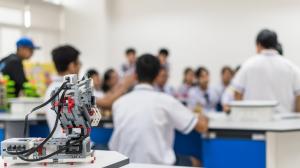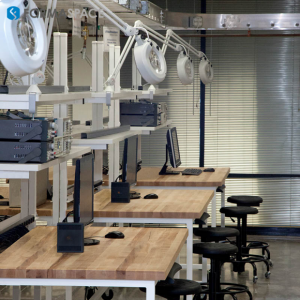
10 Key Design Elements for the Nextgen STEM Schools
Find out more about how STEM instruction will change at K-12 schools and universities in the coming post-Covid environment.
The coronavirus pandemic has been hard on parents, students, teachers, and school administrators alike.
Nonetheless, we should celebrate the incredible innovation that’s taken place over the last year as schools and universities across the country were suddenly thrust into providing online classes to an unprecedented degree.
Let’s take a moment to look at one of the most large-scale STEM classes ever offered – a Stanford University computer science department hosted its introduction to computer programming (using Python), dubbed “Code in Place,” to a massive online audience of over 10,000 students, over 900 section leaders, and 50 teaching leads. (The class will be repeated in the spring; applications to be a section leader are now open and student applications will be accepted starting on April 2.)
How Will The Post-Pandemic STEM Classrooms Change?
However, as impressive as the sudden shift to online instruction has been, most of us are eager to return to normalcy.
Fortunately, we can now see the light at the end of the tunnel.
Schools and universities will be able to reopen to full capacity in the near future, thanks to the rollouts of highly effective coronavirus vaccines from Moderna, Pfizer, and others.
Now is the time to resume planning for the future of STEM education facilities, particularly in light of the increased funding that school districts will receive thanks to the American Rescue Plan Act of 2021.
But how will new STEM school initiatives change the built environment in the coming post-pandemic years?
The NextGen STEM Curriculum Is Being Adopted By More States
The biggest change may come from the STEM curriculum itself.
The general public may unaware of the state-by-state revolution that’s been taking place in STEM education over the last 10 years: the introduction of the Next Generation Science Standards in 2013.
The Next Generation Science Standards (NGSS) were designed by education groups in engineering and science disciplines, including members of the National Science Teachers Association, concerned about developing higher-order thinking skills among students.
What Makes NextGen STEM Different From Past Standards, Such As Common Core?
In contrast to the Common Core Standards, which created a national furor when they were introduced to all 50 states back in 2009, the new Next Generation Science Standards (NGSS) have been able to have been able to “fly under the radar” since they were introduced in 2013. (To date, only 26 states have adopted NGSS.)
The main difference between the two approaches is that students learning under NGSS will need to focus on developing an ability to analyze problems, evaluate alternatives, and create solutions.
Students learning under NGSS will also be assessed on their ability to apply their acquired knowledge to solve problems – rather than memorize individual facts in preparation for a standardized test.
What Are The Implications Of NextGen STEM For Architects, Designers, And Facility Planners?
What should architects, designers, and facility planners know about next-generation STEM curriculum to make effective design decisions when building new campus facilities at K-12 and college campuses?
Ten Key Design Elements That Support NextGen STEM Schools
We have identified the 10 key design elements that are shaping NextGen STEM school design:
1. Combine Previously Separate Departments Into Large Multidisciplinary Hubs
The biggest design change for STEM educational facilities has come from the realization that the architecture should reflect the multidisciplinary approach of the STEM curriculum.
In other words, where possible, it’s more effective to create larger facilities that blend the constituent STEM disciplines of computer science, mathematics, physics, chemistry, engineering, etc. science and engineering into multidisciplinary “hub” facilities.
Many educational institutions are also taking the opportunity to integrate the arts within new STEM facilities, an approach known as STEAM. This makes a lot of sense, given that many types of art instruction intersect with the “make” culture of STEM, including perspective drawing for 3-D product design, figurative drawing and dance motion game character development, graphic design for user interfaces, drama for presentation skills, and music for video productions.
2. Partner With Outside Organizations And Business
One of the major goals of STEM education is to prepare students for successful technical careers in the workplace.
But, with technology changing so quickly, it’s difficult for educational institutions to keep up with what industry needs from year-to-year.
The solution for many schools is to create direct partnerships with outside businesses and other organizations to integrate industry knowledge with the school curriculum.
Students also benefit by making direct contact with individuals working in the industry, whether through industry presentations, open houses, mentorships, or internships.
This is especially important for women and economically disadvantaged minorities who may not have had enough exposure to careers in science and technology to realize how many opportunities exist for them to pursue STEM classes that can lead to a rewarding future career.
3. Pursue A New Approach To Funding That Turns Architecture Programming Upside Down
The traditional approach used by architects and designers to identify the architectural programming requirements for a new STEM facility typically began by interviewing faculty members in a particular department to identify their wishes, needs, and budget requirements for a new building.
What typically emerged from this approach was a proposal for a new building that was slightly bigger than the one it was replacing.
This “silo” approach – of focusing on only one department at a time – also results in a missed opportunity to create a truly transformative solution for STEM instruction across the entire institution.
Read more...
Julia Solodovnikova
Formaspace
+1 800-251-1505
email us here
Visit us on social media:
Facebook
Twitter
LinkedIn
School Systems In 26 States Worked Together To Create The New NGSS Curriculum, Which Places The Focus On Students Learning Science By Doing Science.
Distribution channels: Business & Economy, Education, IT Industry, Science, Technology
Legal Disclaimer:
EIN Presswire provides this news content "as is" without warranty of any kind. We do not accept any responsibility or liability for the accuracy, content, images, videos, licenses, completeness, legality, or reliability of the information contained in this article. If you have any complaints or copyright issues related to this article, kindly contact the author above.
Submit your press release


